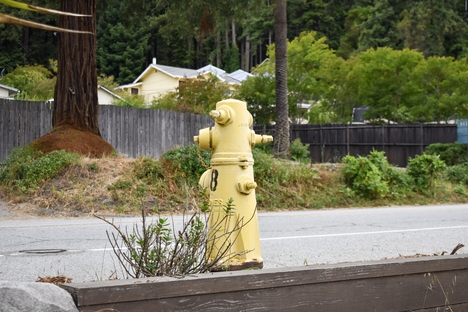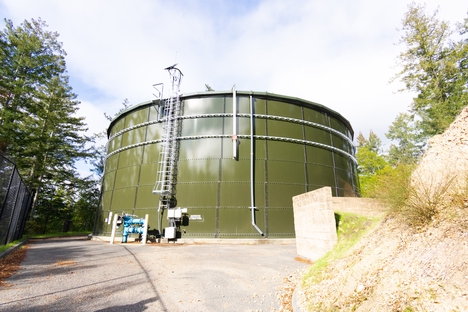A Water Agency’s Perspective on Fighting Wildfires
As a water agency, we see firsthand the vital role water plays in every aspect of life—from meeting daily needs such as cooking, cleaning and bathing to irrigating parks and protecting communities during crises. The wildfires that devastated Southern California earlier this year have underscored the critical importance of water. Our hearts go out to those affected communities, as we also remember the Paradise Fire in 2018 and the CZU Lightning Complex fires in Santa Cruz County in 2020.
Urban Water Systems: Designed to Fight Urban Fires, Not Wildfires
 Municipal water systems in cities and towns are carefully engineered to meet the daily needs of homes, businesses, and public services, as well as emergency demands. In urban areas, fires are typically localized, such as a house fire, affecting only a small part of the community. Common causes include electrical faults, gas leaks and cooking accidents, with the spread of fire usually limited to the property where it started or its immediate surroundings.
Municipal water systems in cities and towns are carefully engineered to meet the daily needs of homes, businesses, and public services, as well as emergency demands. In urban areas, fires are typically localized, such as a house fire, affecting only a small part of the community. Common causes include electrical faults, gas leaks and cooking accidents, with the spread of fire usually limited to the property where it started or its immediate surroundings.
When firefighters open a hydrant to combat an urban fire, large volumes of water are rapidly withdrawn, which can lower water pressure throughout the system. This may temporarily reduce availability for other hydrants in the network. When the urban fire is extinguished, the system pressure returns to normal and hydrants are available for the next incident.
However, wildfires are far larger in scale and are driven by natural factors like lightning or by human activities such as campfires, discarded cigarettes or arson. Strong winds and dry conditions allow wildfires to spread rapidly, leaping over roads, rivers and firebreaks, making containment exceptionally challenging.
Urban water systems are not designed to combat catastrophic wildfires, especially those that recently impacted Southern California, where fire hydrants alone are insufficient. In such cases, alternative water sources—such as tanker trucks and aerial firefighting resources—become critical.
During typical urban fires, we rely on real-time monitoring of water tanks, pressure levels and flow rates within our distribution system. During the CZU fire, even as Scotts Valley faced strict evacuation orders, essential District staff remained on-site to ensure water service was maintained. We also maintain emergency generators to keep wells and pumps operational in case of power outages. When storage tanks deplete to support firefighting efforts, wells and pumps automatically activate to replenish them.
Protecting Water Quality During Fires
Wildfires pose significant risks to water quality. Extreme heat can damage infrastructure, melting pipes and making water systems vulnerable to contamination from ash, debris and fire retardants. Many utilities in the L.A. area issued “Do Not Drink” or “Boil Water” notices, while water quality testing and contamination mitigation efforts were underway. Ensuring safe water access during and after a wildfire adds another layer of complexity to disaster response.
The Bigger Picture: Climate Change and Water
 Wildfires are no longer rare events. Rising temperatures, prolonged droughts, and increasingly extreme weather patterns are placing unprecedented strain on California’s water resources. And when precipitation occurs, it often comes in the form of short, intense storms, leading to runoff and flooding rather than meaningful groundwater and reservoir replenishment.
Wildfires are no longer rare events. Rising temperatures, prolonged droughts, and increasingly extreme weather patterns are placing unprecedented strain on California’s water resources. And when precipitation occurs, it often comes in the form of short, intense storms, leading to runoff and flooding rather than meaningful groundwater and reservoir replenishment.
Local water agencies face growing challenges, including maintaining reliable supplies for daily use, protecting water sources amid worsening droughts, and planning for long-term resilience. As an active member of the Santa Margarita Groundwater Agency, we support the agency’s groundwater sustainability plan, which includes water efficiency measures, groundwater management strategies and development of supplemental water supplies. Additionally, we collaborate with other water agencies in the region to facilitate water transfers and maintain emergency interties.
A Commitment to Resilience
Water sustains, protects and connects us. As stewards of this vital resource, we have a profound responsibility to manage it wisely and ensure its availability, especially in times of crisis.
The scale of the recent wildfires is staggering, reinforcing the importance of emergency preparedness and the realities of climate-driven natural disasters. We extend our deepest sympathies to the families affected, our gratitude to the firefighters who risk their lives on the front lines, and our appreciation to the dedicated water utility workers and resilient communities working toward recovery.

